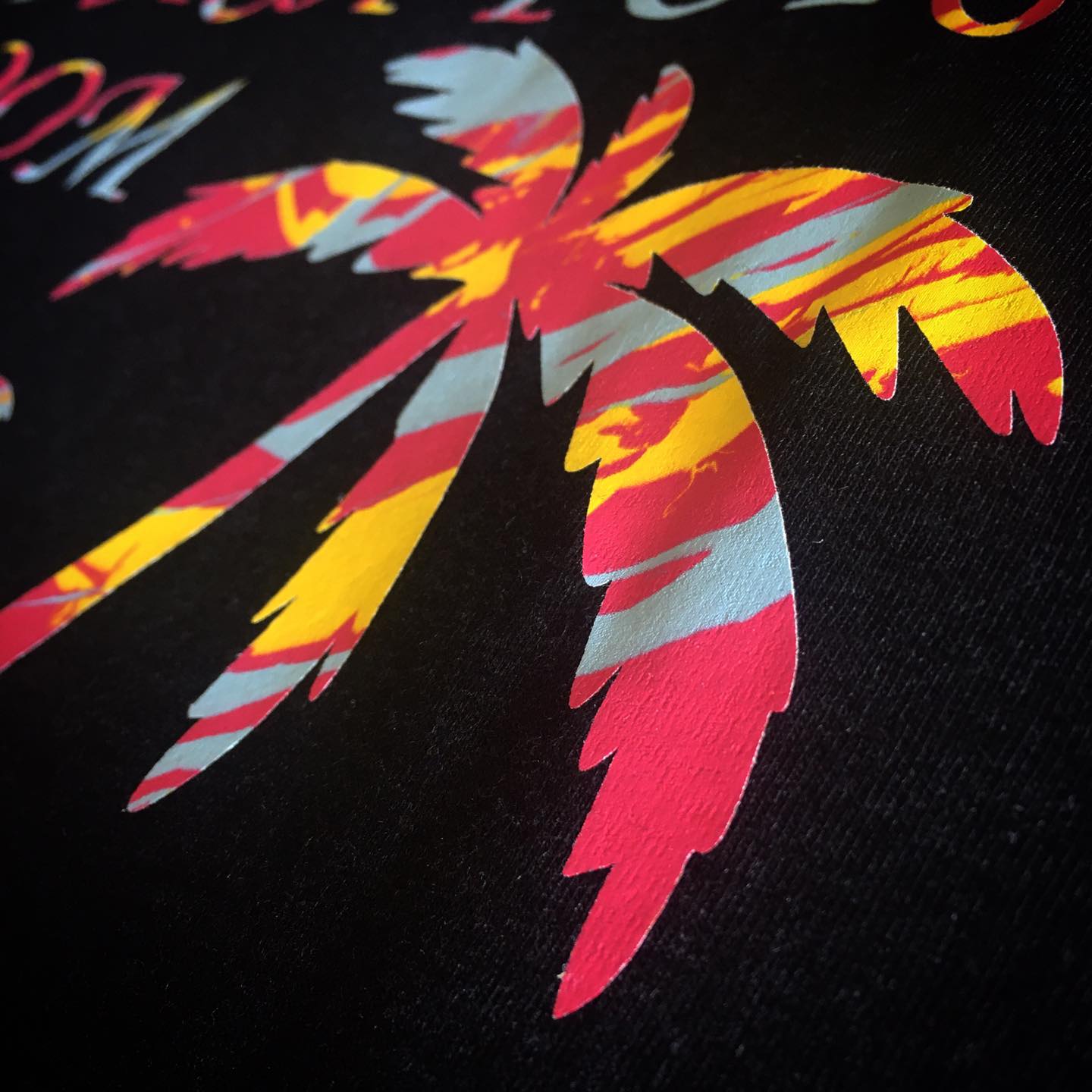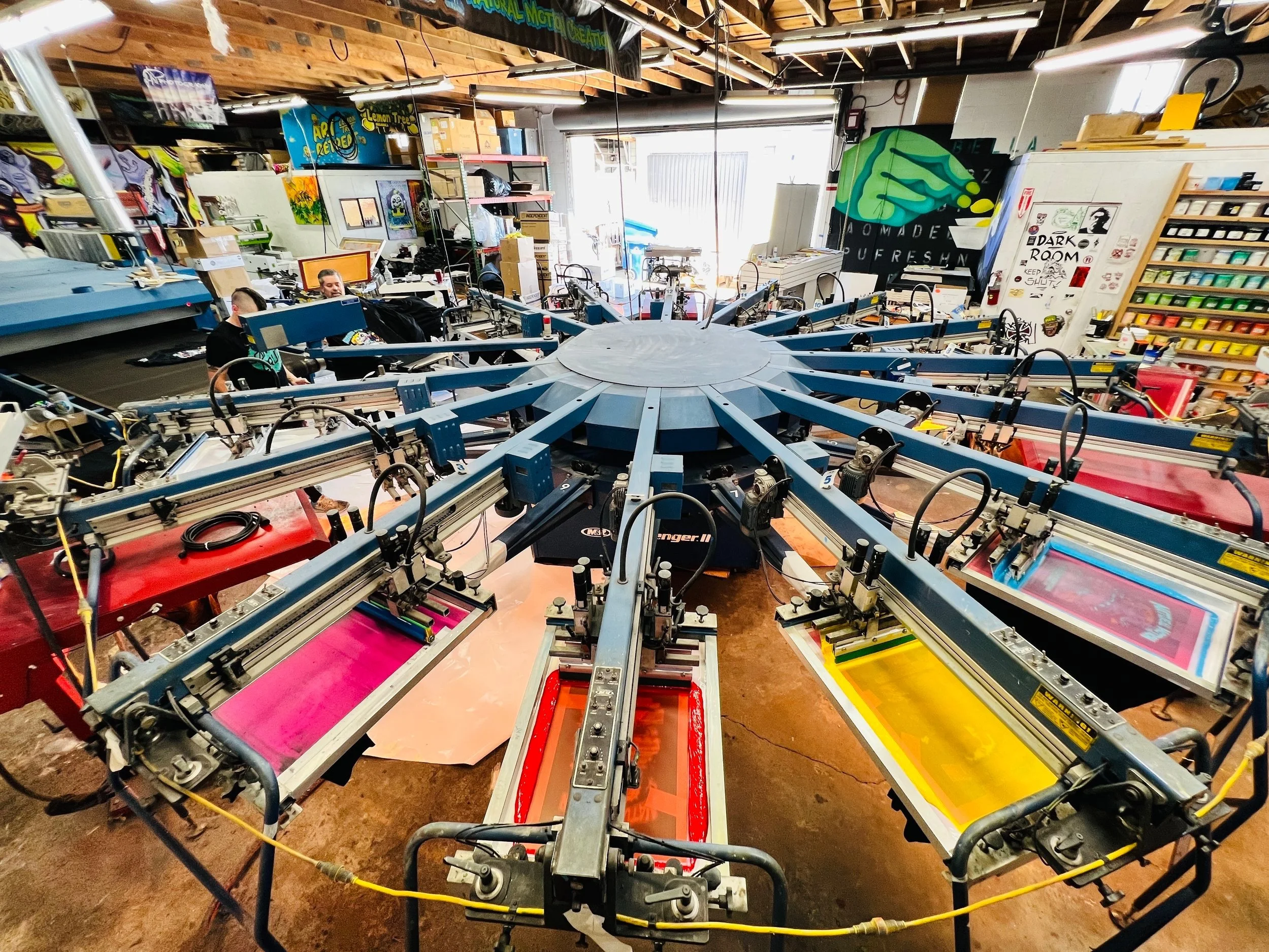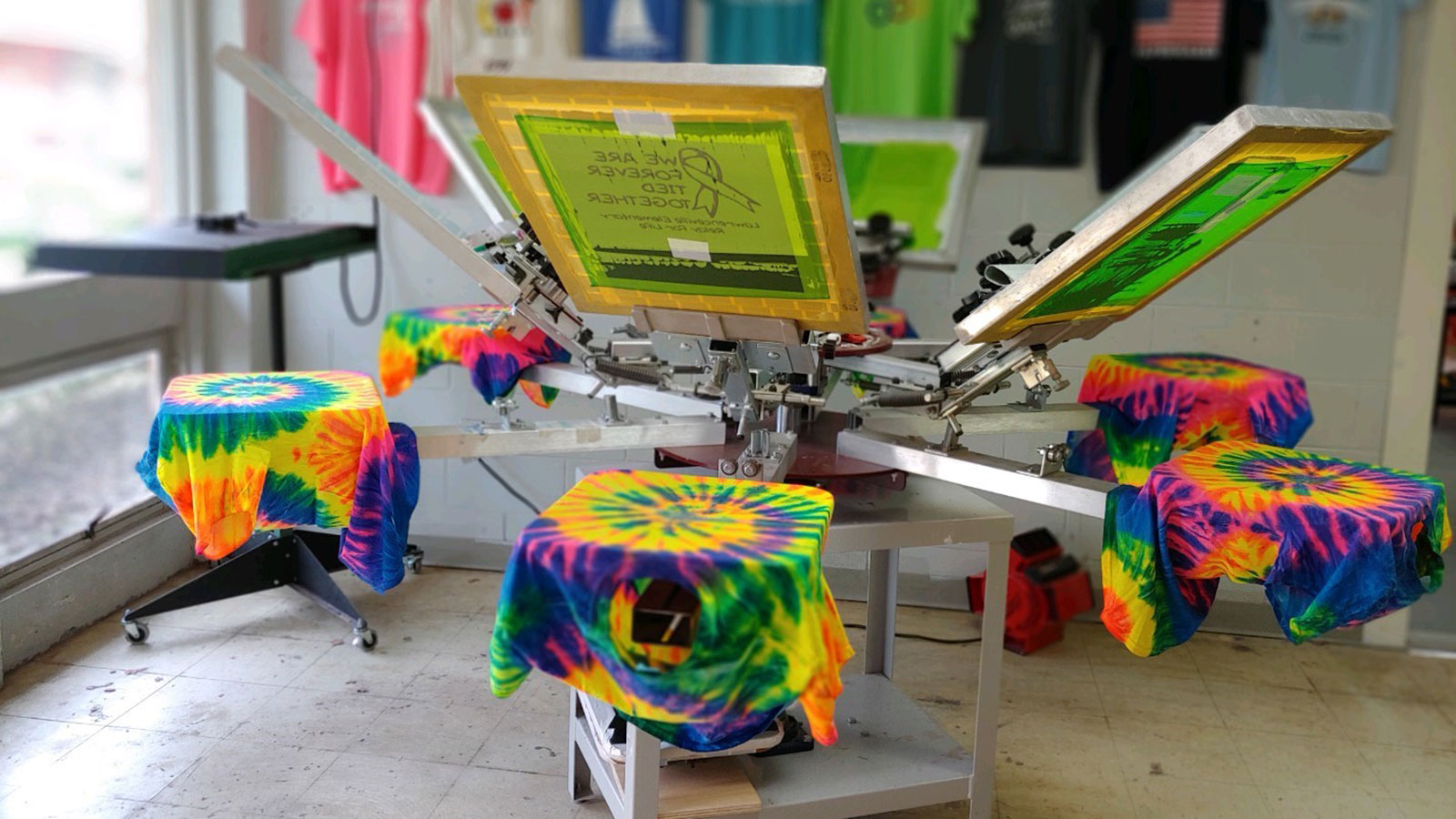Detailed Silk Screen Printing for Custom Art Apparel
Wiki Article
Screen Printing Uncovered: Every Little Thing You Required to Understand About Tee Shirt and Garment Printing Methods
If you have actually ever questioned just how those lively designs finish up on your favorite tee shirts, you're in the best location. Display printing is a fascinating approach that incorporates art with technique, supplying limitless opportunities for creative thinking. Understanding the principles, from devices to ink selections, can greatly affect your outcomes. Ready to discover the essential components that make display publishing an art form? Allow's reveal the details that can boost your jobs.
The Basics of Screen Printing: Exactly How It Works
When you dive into screen printing, you'll discover it's both a scientific research and an art. At its core, display printing includes creating a pattern, or screen, that permits ink to travel through only in certain locations (screen printing kit). You begin by picking your design and preparing your display with a light-sensitive solution. When you expose this emulsion to light, it hardens, leaving your style as an unfavorable area.Next, you'll blend your inks and prepare your printing surface area. Placement the screen over the fabric, after that make use of a squeegee to push ink through the display onto the garment. This process calls for accuracy, as you want clear, vibrant prints. After printing, you'll cure the ink with warmth, ensuring it sticks to the fabric and lasts with cleans. Each action is necessary, and mastering them will certainly boost your screen printing skills, transforming basic garments into unique, meaningful items.
Kinds Of Display Printing Techniques
Once you grasp the fundamentals of screen printing, it's time to check out the numerous strategies that can elevate your layouts. One popular approach is traditional screen printing, where ink is pushed through a stenciled screen. This strategy is great for bold, dynamic colors. Then there's water-based ink printing, which provides a softer feeling and is environmentally friendly, however it needs a various method to healing.If you're going for fine details, think about discharge printing. This technique gets rid of color from the fabric, leaving a soft, vintage look. Another alternative is plastisol printing, known for its sturdiness and dazzling colors, making it a favored for numerous brands. Experiment with halftone printing to create gradient effects and elaborate styles. Each method has its one-of-a-kind beauty, so don't wait to attempt them out to locate what fits your design best!
Essential Equipment for Screen Printing
To accomplish stunning lead to screen printing, having the ideal equipment is basic. You'll need a durable screen printing frame, which holds the mesh that transfers your design onto the garment. Next, invest in premium squeegees; these are important for using ink equally across the display. You'll likewise call for an excellent direct exposure unit to produce your displays, along with a washout cubicle for cleansing them after usage. A dependable heat resource, like a conveyor clothes dryer or warm press, is vital for healing your prints to guarantee durability. Do not forget a proper work space, geared up with tables and storage for your products. Ultimately, safety equipment, such as handwear covers and masks, will keep you secure from chemicals and inks. With the right devices, you'll be well on your means to generating professional-quality prints.Picking the Right Inks and Materials
When selecting inks and materials for screen printing, you need to consider the kind of ink that works finest for your project. Consider textile compatibility to assure your styles look last and terrific lengthy. Check out environmentally friendly ink alternatives to make your printing process a lot more lasting.Kinds of Display Inks
Choosing the appropriate screen ink is crucial for accomplishing lively, resilient prints that satisfy your task's needs. There are numerous types of display inks to analyze. Specialty inks, such as glow-in-the-dark or metallic, can include one-of-a-kind effects to your layouts.
Fabric Compatibility Considerations
Recognizing textile compatibility is essential for attaining top notch screen prints, especially because various products react distinctly to numerous inks. When selecting inks, take into consideration the material kind-- cotton, polyester, or blends. For cotton, water-based inks work well, using gentleness and breathability. Polyester, on the various other hand, commonly calls for plastisol inks for better bond and dynamic shades. If you're printing on blends, you might need to use a combination of both types. Constantly evaluate your inks on sample fabric to ensure they adhere effectively and preserve shade stability. Additionally, bear in mind that fabric weight and texture can influence the final end result, so choosing the best ink and product combo is important for your task's success.Eco-Friendly Ink Options
Eco-friendly inks are becoming a popular choice for display printers that desire to minimize their custom screen printing ecological impact while preserving top quality. When choosing inks, take into consideration water-based inks, which are much less unsafe and less complicated to cleanse up compared to standard solvents.In addition, seek inks made from eco-friendly sources, such as soy or vegetable-based options. By picking the best inks and products, you'll not only produce stunning layouts however likewise add to an extra lasting printing process. Make the button, and your prints will mirror your dedication to the atmosphere!
Preparing Your Style for Screen Printing

Submit Style Requirements
To ensure your layout looks sharp and vivid on fabric, you'll require to pay close attention to submit layout requirements for screen printing. Beginning with vector documents like AI or EPS, as they can be scaled without losing quality. If you utilize raster pictures, choose for high-resolution data, such as TIFF or PNG, ideally at 300 DPI. Stay clear of making use of JPEGs, as they can lose quality when resized. Also, make certain your style has a transparent background to prevent undesirable white sides on your prints. Finally, maintain shade settings in mind; CMYK is standard for screen printing, so transform your RGB develops as necessary. By complying with these guidelines, you'll set your art work up for an effective print.Color Splitting Up Strategies
Color separation is a necessary step in preparing your style for display printing, and grasping it can substantially improve your print quality. You'll require to damage your design right into specific colors, as each shade calls for a different display throughout printing. Beginning by identifying all the colors in your layout and produce layers each. You can use software application like Adobe Photoshop or Illustrator to isolate and separate colors efficiently. Be certain to conserve each layer as a different file, normally in a layout like TIFF or PSD. This accuracy not only ensures precise shade representation but additionally streamlines the printing procedure. By taking note of shade splitting up, you'll attain dynamic and professional cause your screen-printed garments.Resolution and Size
Accomplishing the very best lead to screen printing starts with assuring your layout has the right resolution and dimension. Ideally, your art work needs to go to the very least 300 DPI (dots per inch) for sharp, clear prints. If you utilize lower resolution, your final item could look pixelated and amateur.When it concerns size, take into consideration the dimensions of your print location. Layout your art work to match the last print dimension, ideally creating it in the real measurements you'll be printing. In this manner, you'll stay clear of any unanticipated scaling issues.
Always check your layout in both vector and raster styles. Vector graphics can be scaled without shedding high quality, making them suitable for screen printing. Preparing properly will assure your layout looks remarkable on every garment!
Step-by-Step Display Printing Process
Screen printing is a dynamic procedure that enables you to develop lively designs on numerous surfaces. To obtain started, you'll require a display, emulsion, and your chosen ink. Prepare your screen by cleansing it thoroughly. Next off, apply the solution evenly and allow it dry in a dark location. Once dry, reveal your display to light with your layout put on it, which will harden the emulsion where the light hits, developing a pattern - screen printing kit.Pour ink onto the screen and utilize a squeegee to press the ink with the stencil onto the textile. Raise the screen meticulously and allow the print dry. You have actually effectively screen published your design.
Tips for Effective Screen Printing Projects
While you're diving right into your screen printing tasks, keep in mind that preparation is vital to success. Begin by gathering all your products-- inks, displays, garments, and mops. A clean office helps stop undesirable mistakes, so clean up prior to you start.Next, verify your art work is high-resolution and correctly sized for your garment. Test your display for proper direct exposure and clean it extensively to avoid spots. When blending your inks, follow the supplier's guidelines to accomplish the appropriate consistency.
Throughout printing, apply also stress with your squeegee for regular results. Don't hurry; take your time to validate each print meets your criteria. After printing, let your garments dry totally prior to handling or packaging them.
Finally, constantly keep a sample of your benefit future reference. This method, you can evaluate your progression and boost your techniques in time. Delighted printing!

Regularly Asked Questions
The length of time Does It Require To Establish a Display Printing Task?
Setting up a screen printing work typically takes around half an hour to an hour. You'll prepare the screens, mix inks, and adjust journalism. The moment varies based on intricacy and experience, so remain organized!Can I Publish on Various Material Types Using the Exact Same Technique?
Yes, you can print on various textile kinds utilizing the same method, however you'll need to readjust your inks and setups. Some materials absorb ink differently, so experimenting guarantees the very best outcomes for each product.What Are Typical Mistakes to Stay Clear Of in Screen Printing?
When display printing, stay clear of typical errors like using the incorrect ink, disregarding correct direct exposure times, or avoiding pre-press checks. Always test your configuration and keep tidy displays to ensure high quality outcomes each time.How Can I Correctly Clean and Keep My Screen Printing Tools?
To appropriately clean and preserve your display printing devices, you need to regularly clean displays with proper solvents, check mops for wear, and guarantee all tools are saved dust-free and dry. Uniformity avoids pricey repair work and boosts efficiency.Is Display Printing Eco-friendly Contrasted to Other Methods?
Screen printing can be a lot more environmentally friendly than other approaches, specifically if you utilize water-based inks and eco-conscious products. By choosing sustainable materials and techniques, you reduce waste and reduce your influence on the planet.Screen Printing Uncovered: Whatever You Required to Know Concerning Tee and Garment Printing Techniques
At its core, screen printing involves producing a stencil, or display, that enables ink to pass via just in details areas. Setting the display over the textile, after that use a squeegee to push ink through the screen onto the garment. One popular method is conventional screen printing, where ink is pushed with a stenciled display.When selecting inks and products for display printing, you require to take right into account the kind of ink that functions ideal for your task.
Report this wiki page